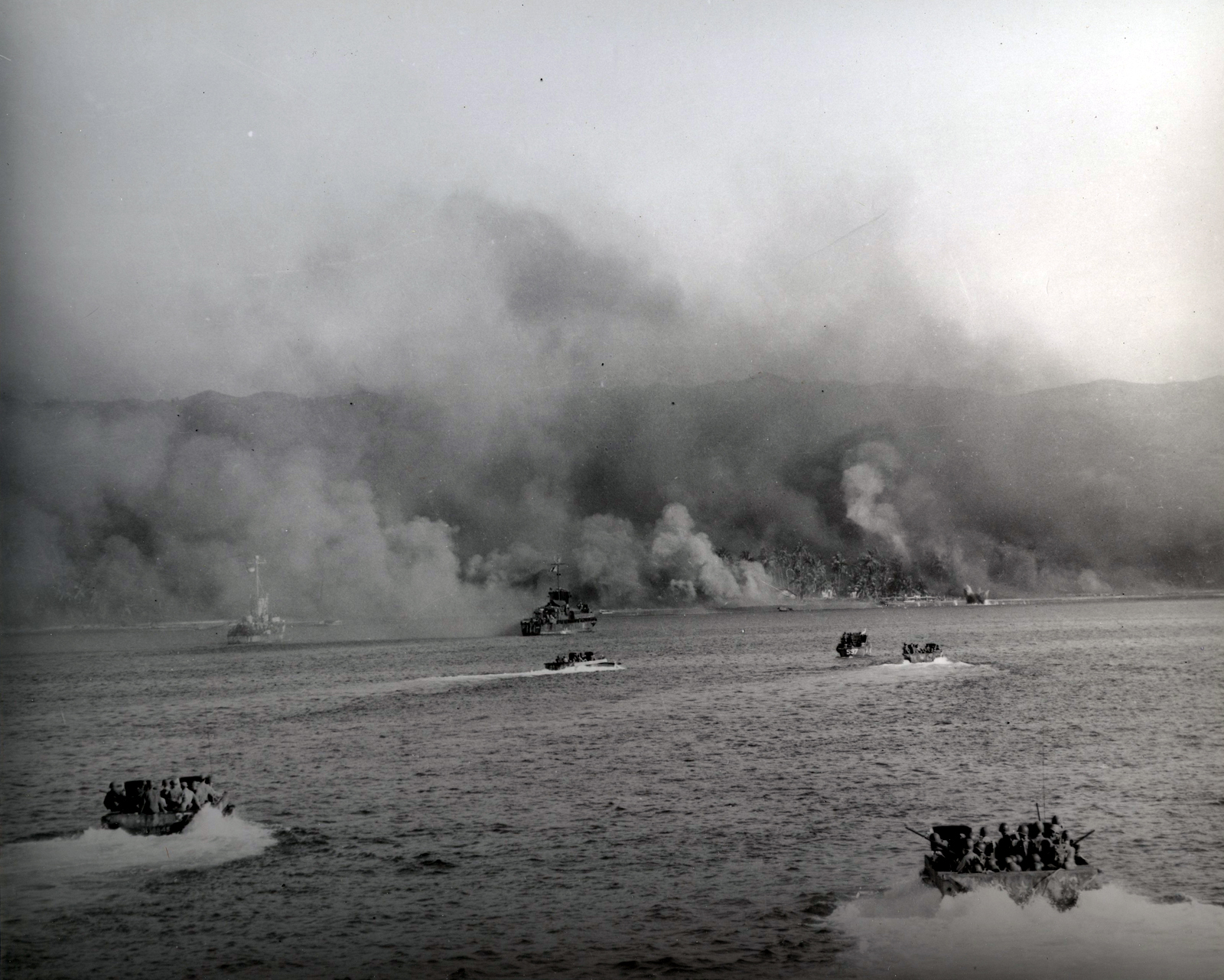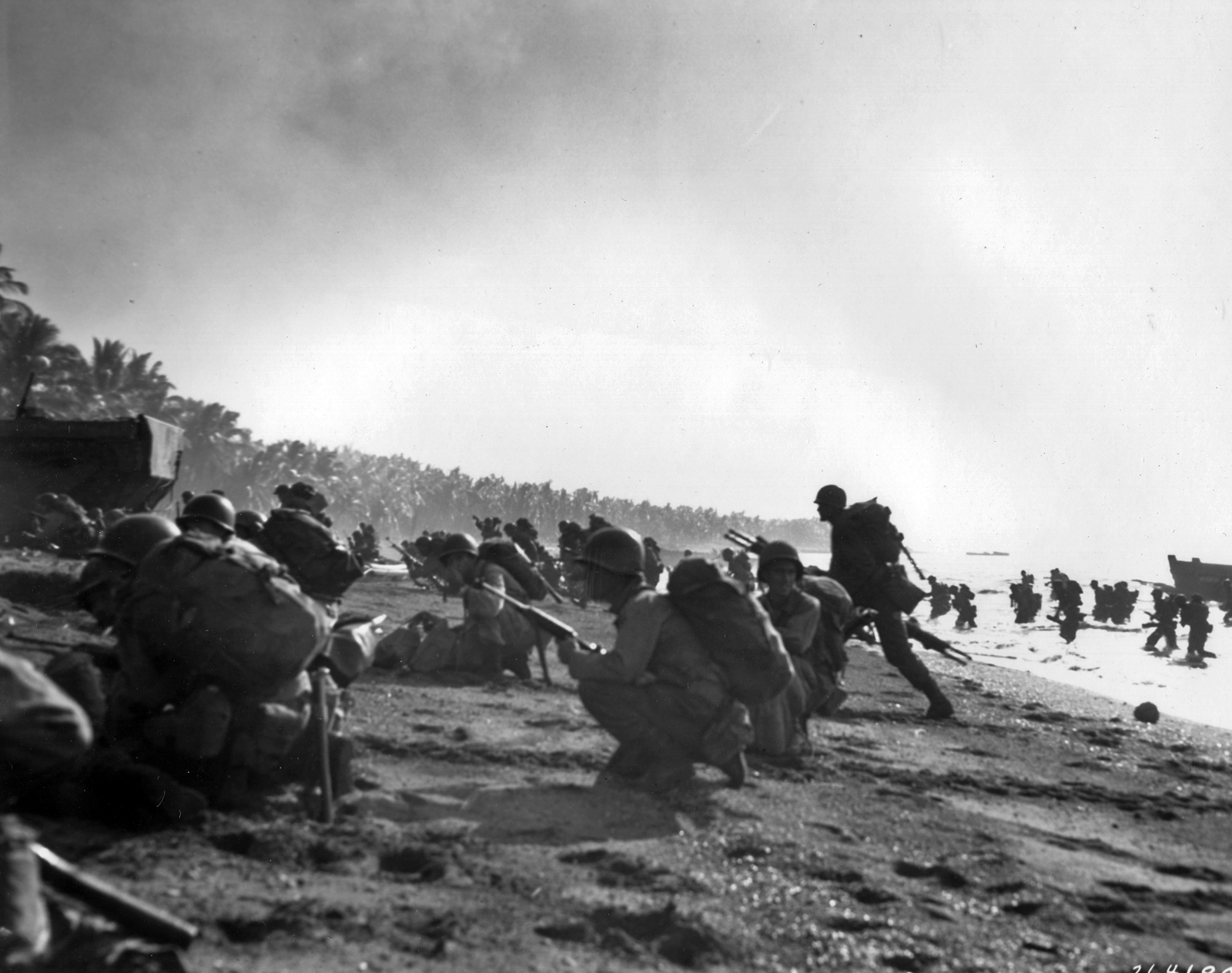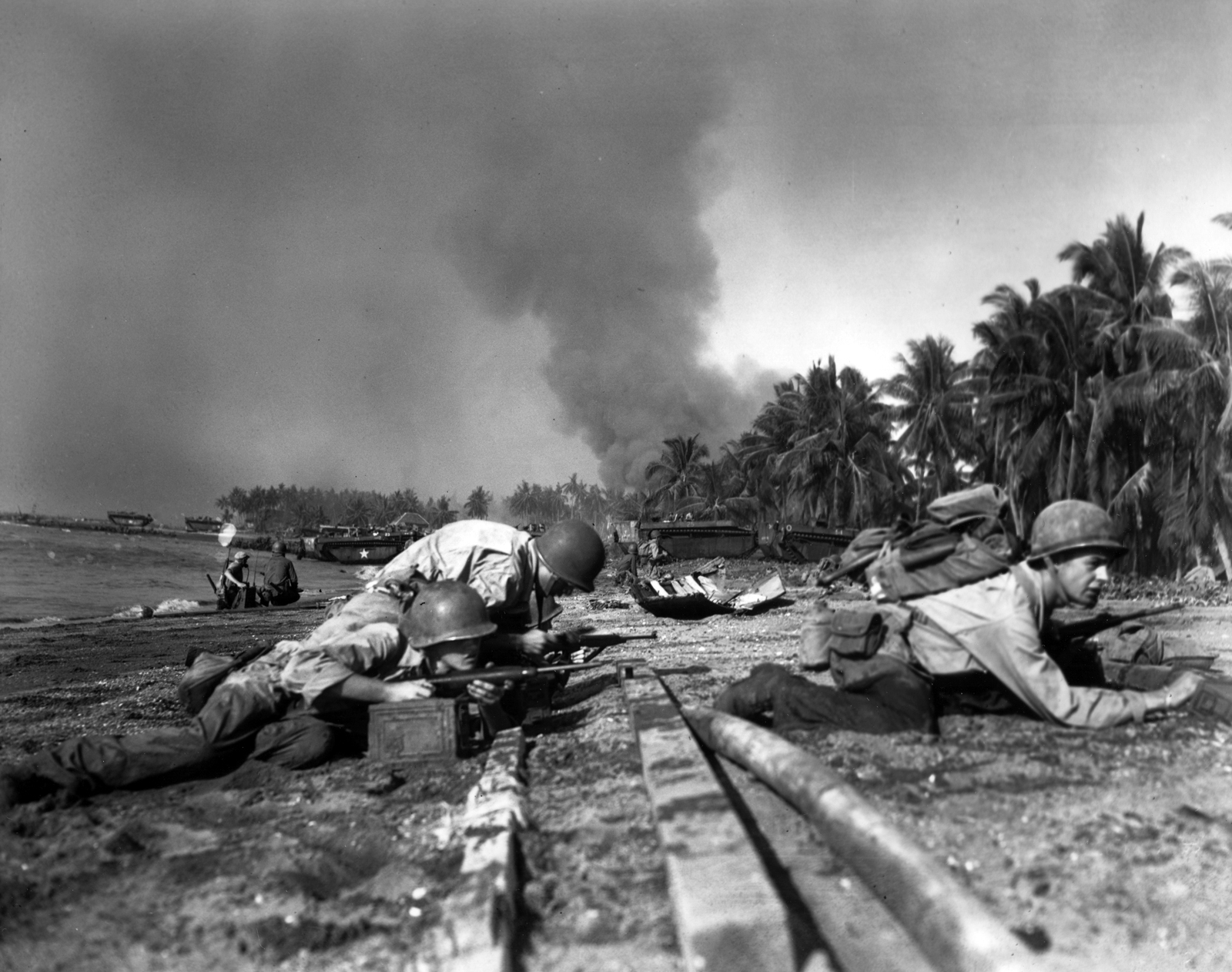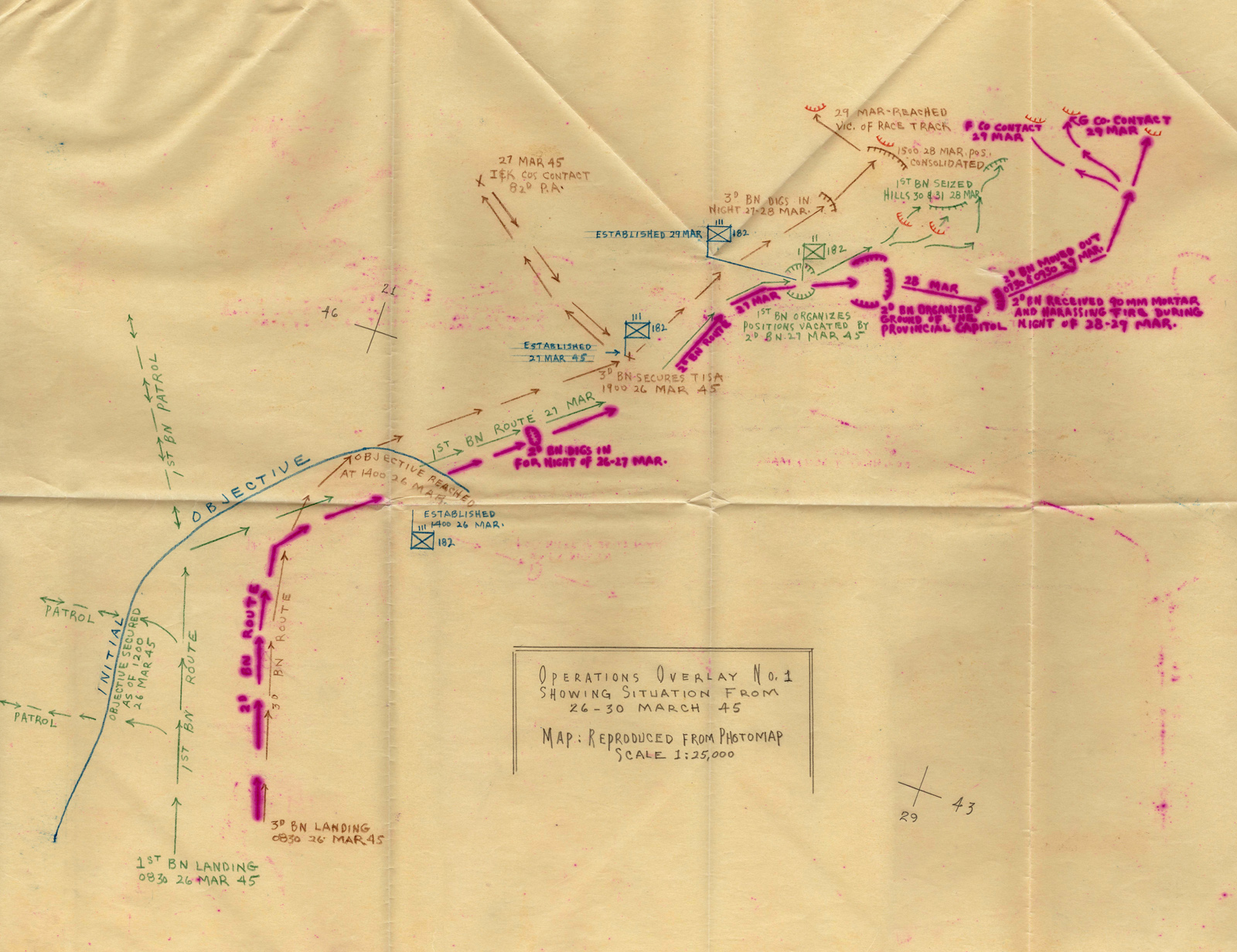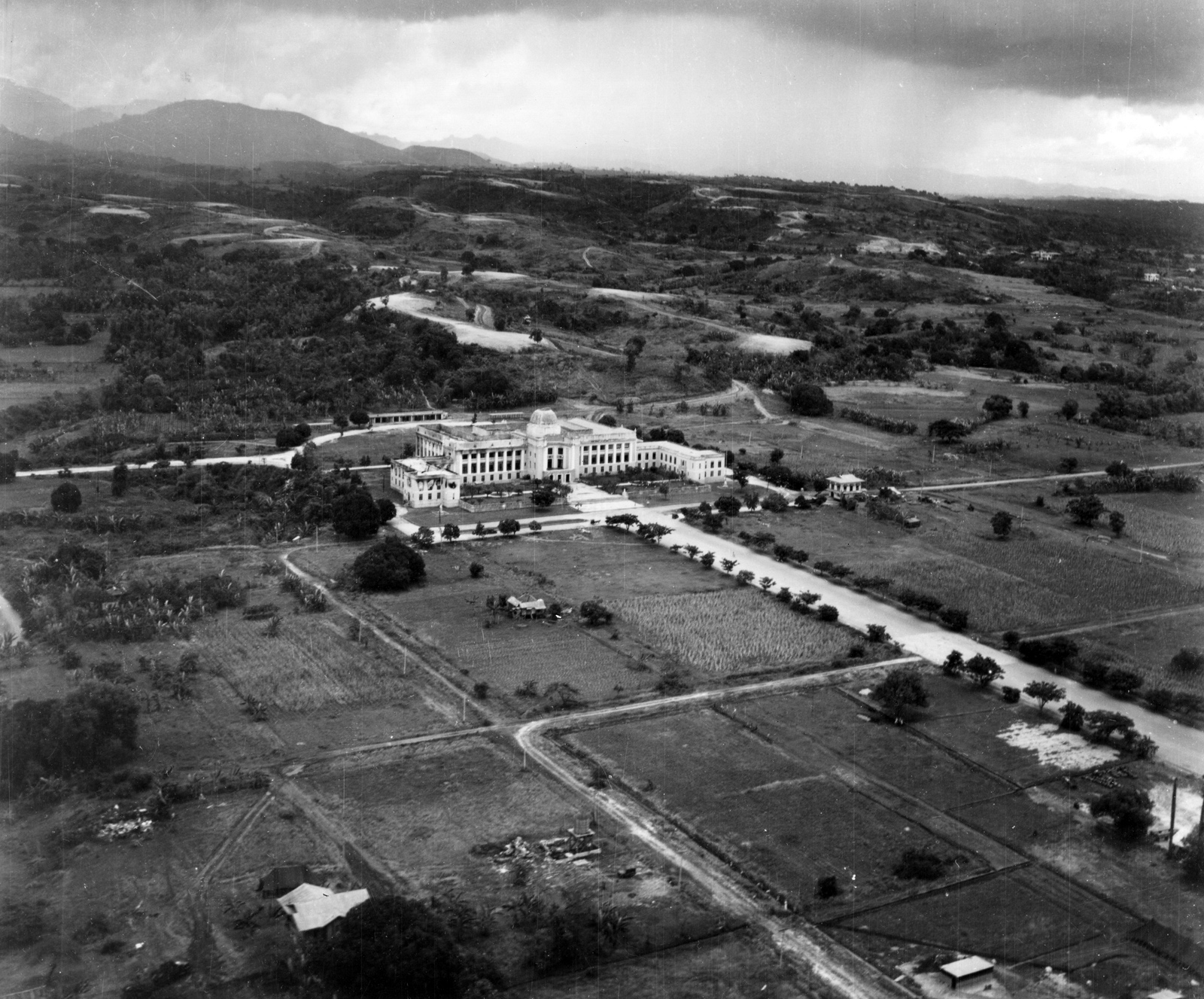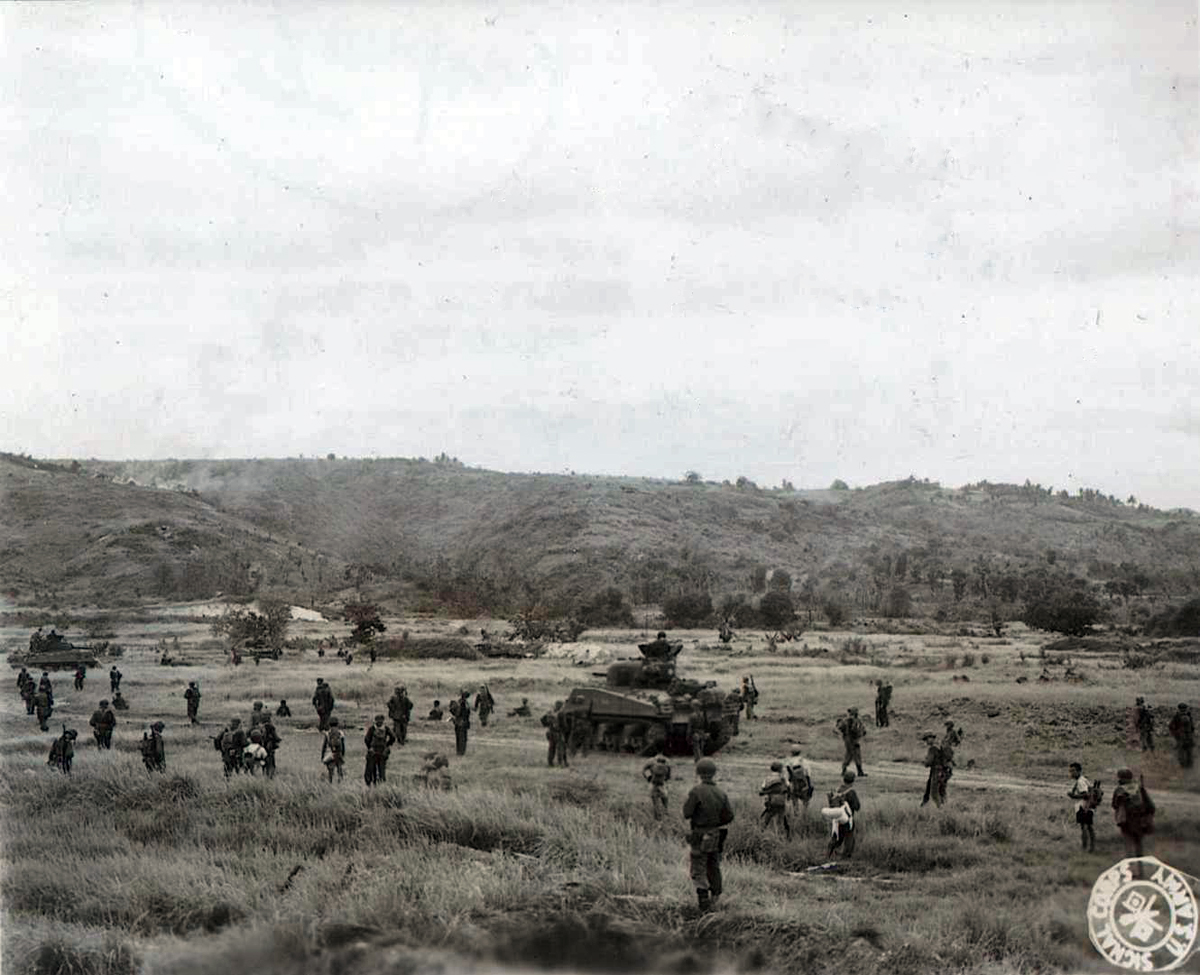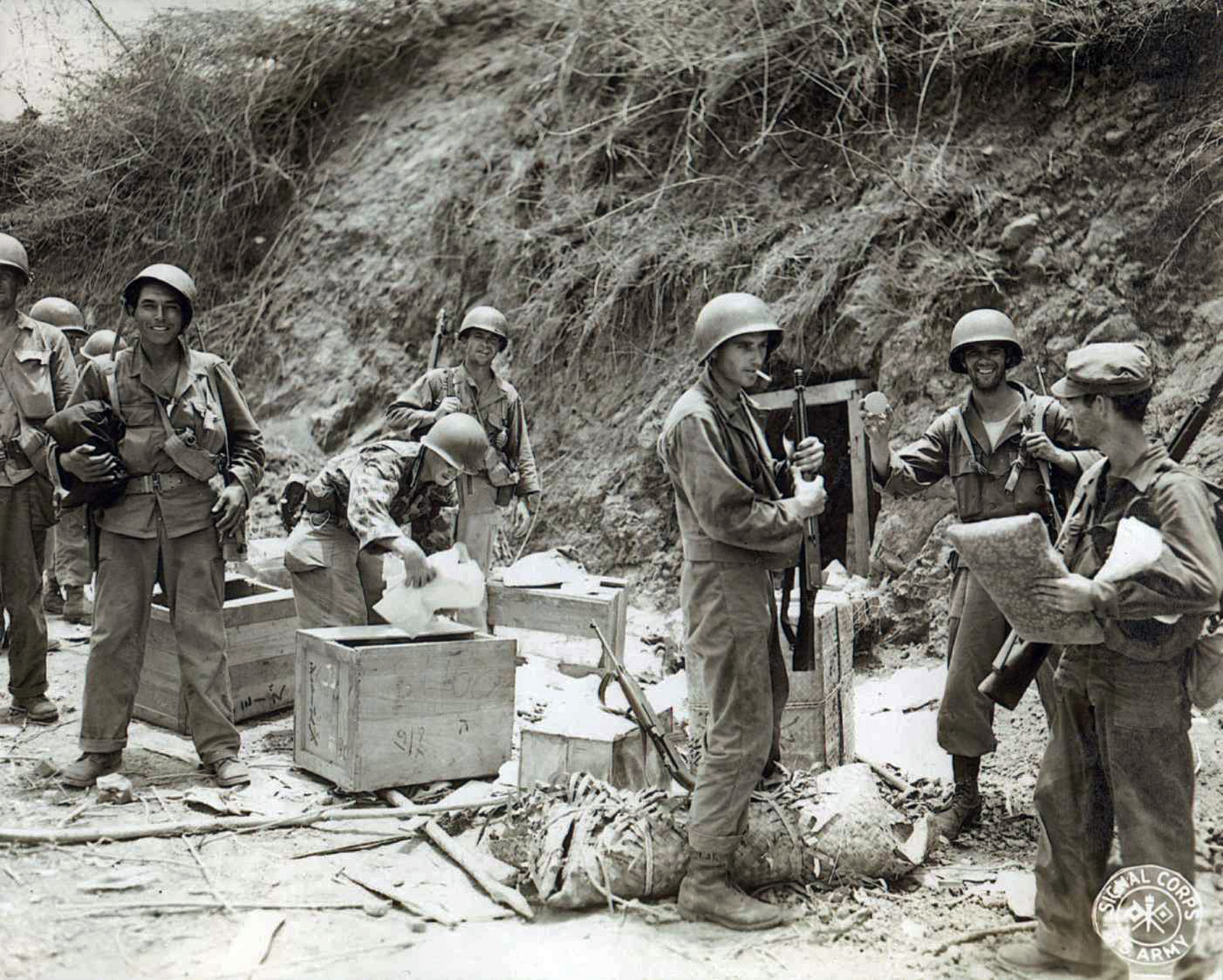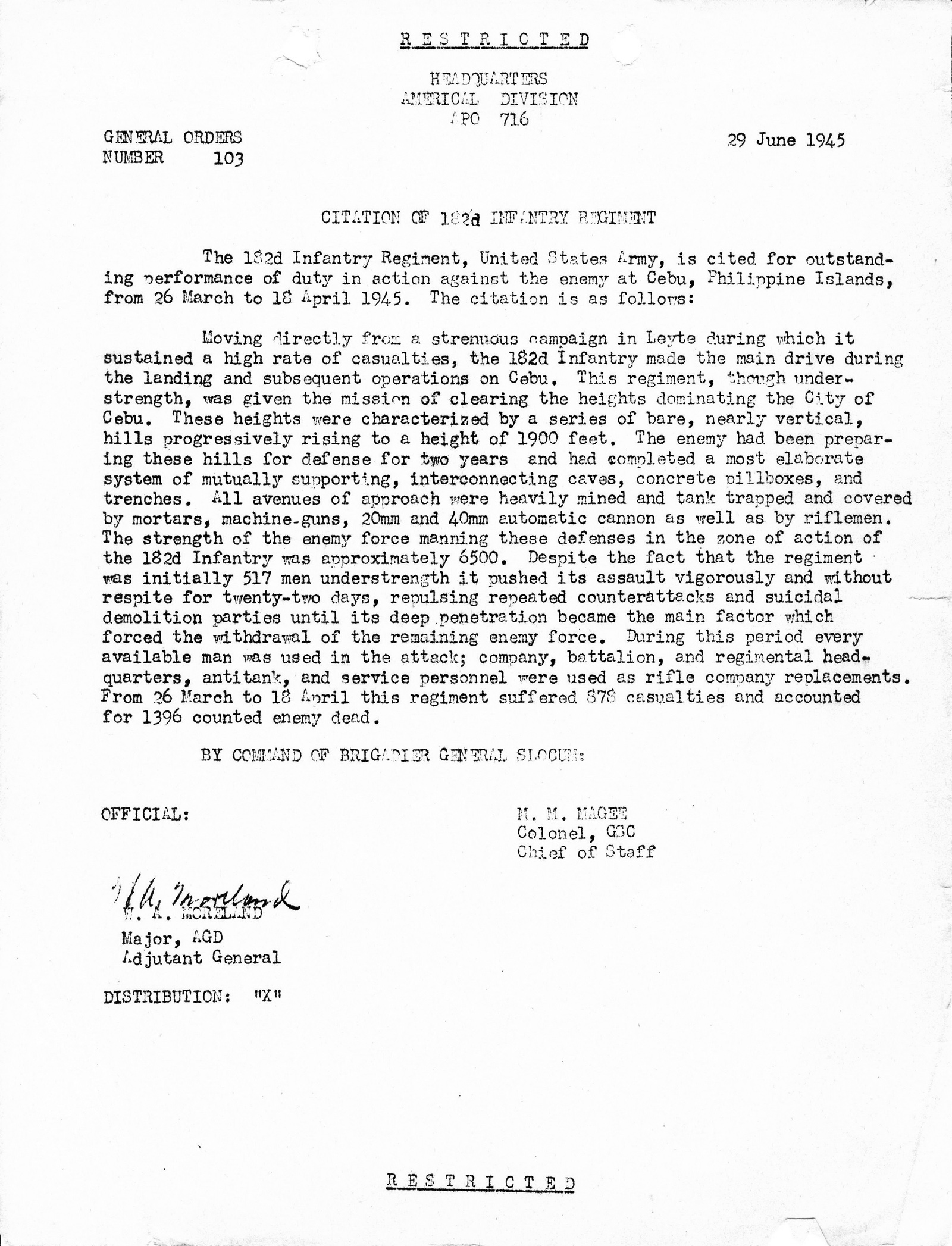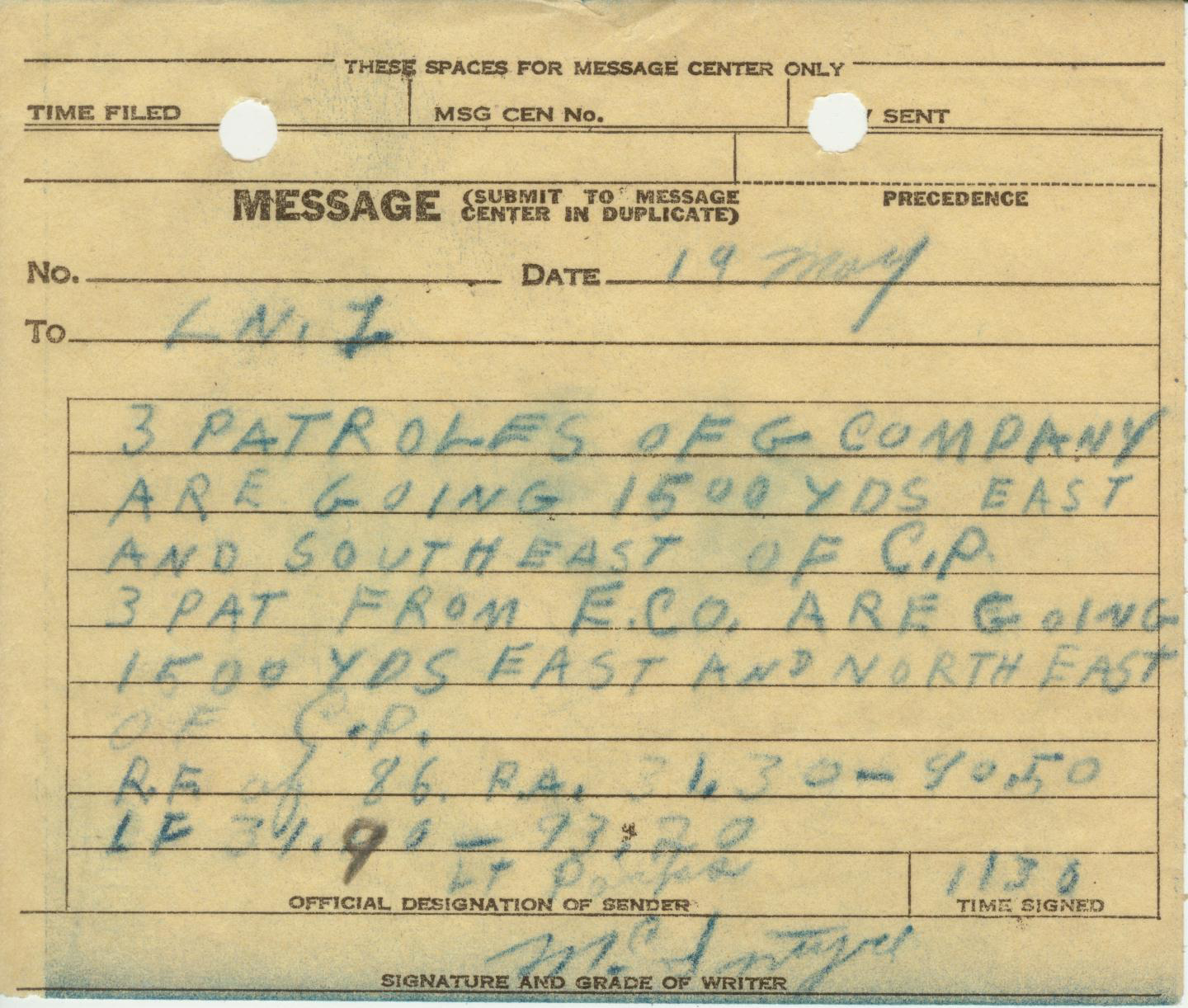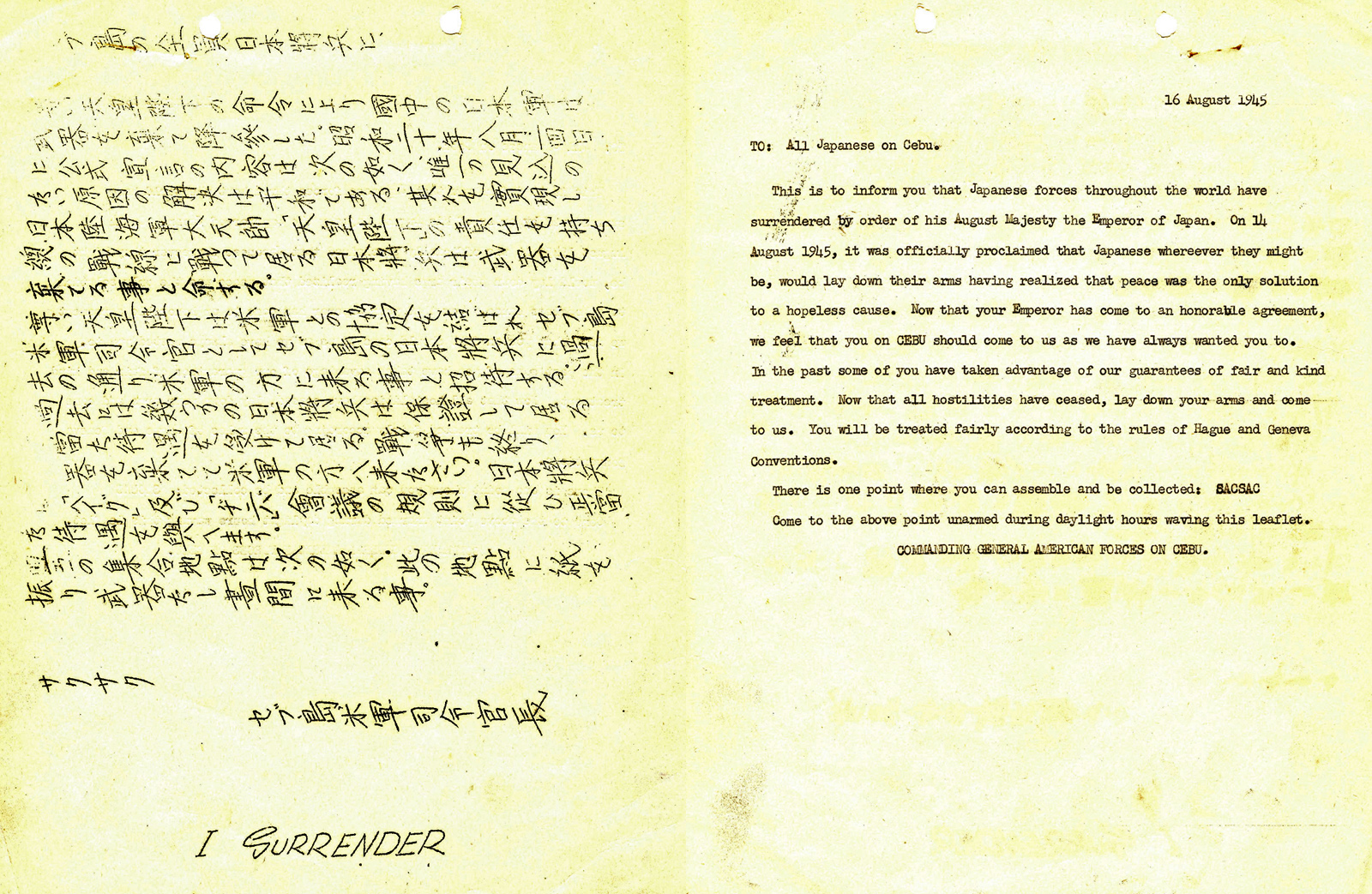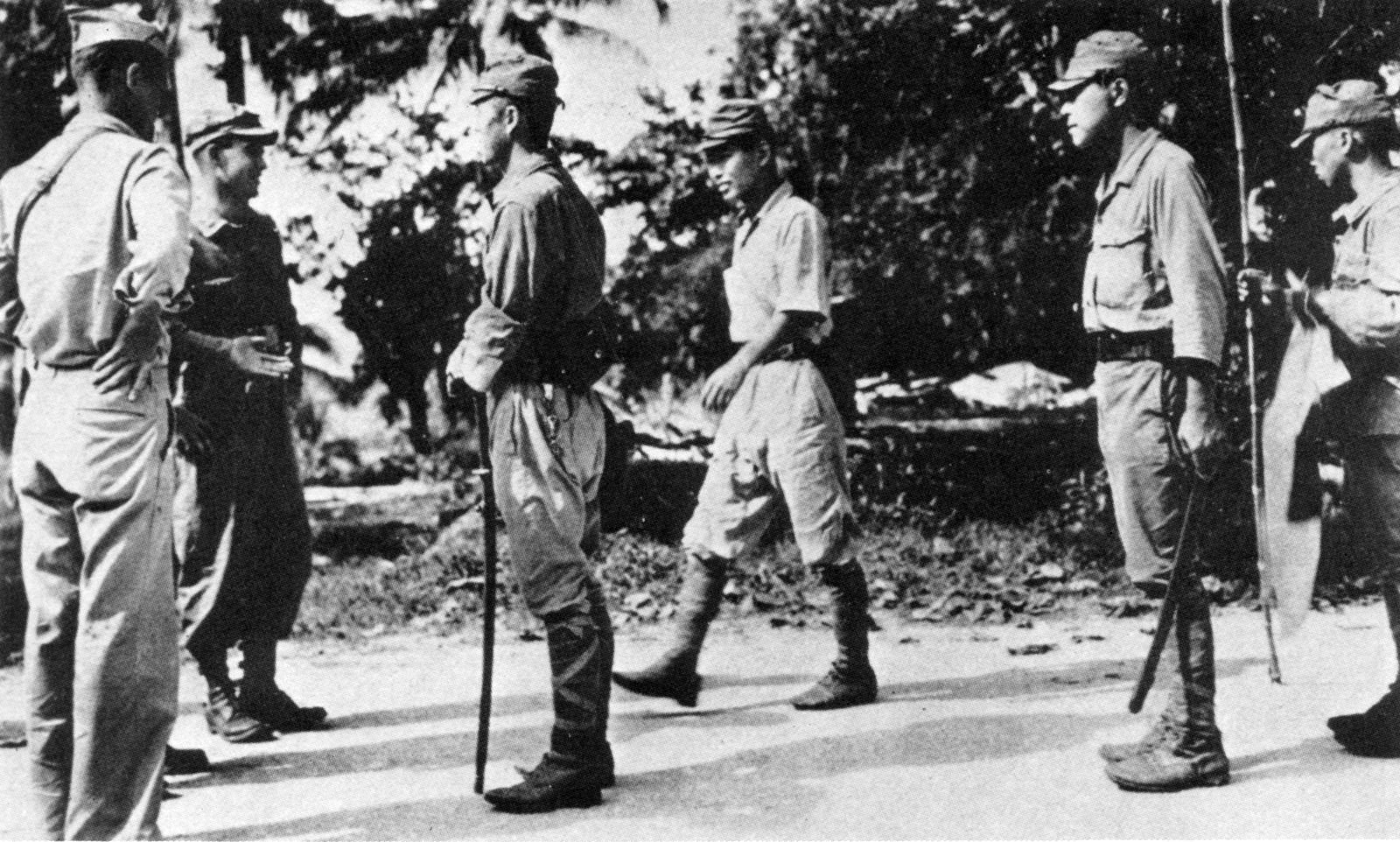Without time to even catch their breath from the fighting on Leyte, the Americal Division was selected for a series of amphibious assaults on other Philippines Islands. The 132nd and 182nd Infantry Regiments were assigned to capture the island of Cebu, just west of Leyte (see Google Map here). Cebu boasted a large harbor, and an airfield at the capital of Cebu City. American intelligence knew the island was occupied by a sizeable Japanese force, but they dramatically underestimated its size. Two regiments of American infantry and other supporting units – less than 10,000 men – were headed into a heavily fortified island defended by perhaps 15,000 Japanese soldiers. The plans for the landing, Operation Victor II, can be read in this 182nd Infantry Field Order #2.
On the morning of 26 March 1945 – designated “E-Day” – the task force bearing the troops of the Americal arrived off the shores of Cebu at Talisay, just a few miles south of Cebu City. The transport ships were protected by cruisers, destroyers, and other supporting craft, as well as aircraft buzzing overhead. For an hour, a deafening salvo of naval gunfire and rockets hammered the shores of the island. In Photo #1, tracked landing vehicles (LVT) swarm in towards the shore. The larger ship at center is an infantry landing craft (LCI), which is the type of vessel that the men of Company G were embarked upon. Smoke masks the landing beach, and an explosion can be seen at the waterline towards the right edge of the photo.
The first wave of troops ashore met with very limited Japanese resistance. But while the enemy had essentially conceded the beachhead, they had left behind a deadly surprise for the Americans. The beach was blanketed with a heavy minefield, which even included large aircraft bombs buried under the sand. 10 of the first 15 to come ashore were disabled by mines. The original plan had been for the tracked amphibious landing craft to lead the push inland once they reached shore. A logjam on the beach began to grow, as minesweeping equipment was not scheduled for deployment until much later in the day. Photo #2 shows soldiers of the 132nd Infantry coming ashore, in a view looking north. The 132nd was responsible for the right sector of the beach, the 182nd the left side – behind the photographer in this photo. Photo #3 also shows the 132nd on the beach, but this view looking south shows the 182nd area of responsibility in the distance. Note the tracked landing vehicles all along the beach. With the logjam on the beach due to the minefield, some landing craft began to pull up short of the beach, and many of the men stepped out of the boat and into deep water, weighed down by their full combat loadout. Some found themselves completely underwater, and struggled to make it to shore.
The chaos on the beach was soon rectified, and paths cleared through the minefield. By late morning, Americal forces began pushing inland towards their objectives. They met only limited resistance, with the 182nd engaging in the only substantial firefight of the day. Most Japanese outposts had been abandoned. One unit from the 182nd discovered an empty shack, full of explosives, with a telephone ringing. But the Japanese were mostly nowhere to be found. There was only scattered resistance, and all objectives were met by the end of the day. The landing had been a success, but the deadliest part of the campaign was ahead. The Japanese defenders of the island had conceded the beach to the Americans, and pulled back into the well defended mountains inland. This was consistent with their overall defensive strategy in the Pacific in 1945. Their plan: allow the Americans to land, and then slaughter them from well concealed, heavily defended positions on high ground.
The map overlay in Photo #4 shows the movements of the 182nd Infantry during the first 3 days of the invasion. The men of Company G moved along the route marked in pink, along with the rest of the 2nd Battalion. On their second day on the island, the battalion moved into Cebu City, and were welcomed by jubilant locals. They advanced on the Provincial Capitol Building, seat of government for the island. Most of the city had been decimated by Japanese occupation and resistance, and American pre-invasion bombardment. The Provincial Capitol Building (seen in Photo #5) had taken damage but was still in pretty good shape. Note the damaged and burned portions of the building which can be seen in the photo. Fred Davis of Company G later wrote that he was first soldier to enter the building. Advancing through a city was a new experience for the jungle soldiers of the Americal, but they found mostly abandoned Japanese positions in a city ruined by Allied air and naval bombardment, and Japanese demolition work. After years of fighting in the jungle, the open plains of the Philippines meant that forces of the Americal could work in concert with armored units.
Beyond Cebu City, the 182nd’s next objection was Lahug Airfield. In Photo #6 taken on 28 March, units of the 2nd Battalion of the 182nd advance with tanks in the vicinity of the airfield. As the soldiers advanced further inland, Japanese resistance increased. Note that the map overlay indicates incoming “90mm mortar and harassing fire” the night of 28-29 March. Company G was almost immediately in contact with the enemy in the foothills outside of town, as seen at the end of the route on the overlay.
The men of the Americal spent early April grinding their way through a series of heavily defended hilltops along Babag Ridge. The first 3 days of the invasion had proceeded smoothly, but now the dug-in Japanese defenders were beginning to rain fire down on the American troops from hidden hilltop emplacements. The men of the 182nd and 132nd turned inland, and began advancing up an imposing mountain ridge that soared as high as 2,000 feet. In the foothills approaching the ridge, virtually an entire company from the 1st Battalion of the 182nd was wiped out when the top of Go Chan Hill exploded in a fireball. A Japanese ammo dump blew up in cataclysmic fashion, either accidentally due to American tank fire into a cave, or (as the men of the Americal believed) intentionally when detonated by retreating Japanese.
Fierce fighting up to the top of Babag Ridge culminated on the night of 12 April, when the men of Company G, with two other companies, unleashed a bayonet charge up a heavily defended hill at the top of the ridge in the dark of night. They made it nearly to the top before the intense Japanese fire forced them to take cover, and by morning, with the assistance of other troops, the hill was taken. In the 24 hour period from 12-13 April, the 182nd reported 7 killed and 51 wounded, against a reported 205 enemy KIA. One member of Company G had a nerve-wracking incident just days later. Ken Vander Molen had joined the company two weeks earlier, along with his twin brother Gordon. On 15 April, in yet another firefight on Babag Ridge, Ken watched as his brother Gordon came sliding down the hill on his back, shot through the shoulder. Fortunately, Gordon was not seriously wounded, and after evacuation, later returned to the unit. The Americal soldiers were forced to root the Japanese defenders out of tunnels and caves all over Babag Ridge. In Photo #7, soldiers of the 182nd rifle through Japanese supplies found in a cave on 19 April 1945.
The Americal Division realized that the Japanese defenders on Cebu actually outnumbered the invading American forces. In fact, later estimates put the number of Japanese in the 182nd Infantry sector at 6500 men – more than double the size of the 182nd. To top it off, the 182nd was running short of men, having come directly from the costly Leyte campaign. And the Japanese were in fixed defensive positions, built months or years earlier, thus heavily camouflaged by vegetation. On 8 April, Company G took on 45 replacement soldiers, to bring the company strength up to 189 officers and men. By 16 April they could muster only 128. They had suffered 61 casualties (killed, wounded, missing, and sick) in less than a week. The 182nd endured 878 casualties in less than a month’s fighting through this rugged, stiffly defended terrain. For their efforts in the first month on Cebu, the 182nd Infantry Regiment was awarded a Unit Citation by the Americal Division – the only time this award was ever bestowed by the division to an entire regiment (see Photo #8). General Douglas MacArthur himself inspected the hills of Cebu that month, surveying the territory conquered by the Americal.
The Japanese presence on Cebu remained large following their defeat on Babag Ridge, but they continued to retreat in the face of the American advance. The 164th Infantry had joined the 182nd and 132nd on the island to help secure Babag Ridge, and the full power of the Americal Division was now brought to bear. The Allies were in full control of the coastal regions of the island, with the Japanese retreating northwards, and finding refuge in the hills.At the end of April, the 182nd was moved by truck to the northwest coast of the island, operating out of Tabuelan and Asturias. Units of the Americal squeezed the remaining Japanese soldiers with pincer movements inland from both coasts. Combat actions continued, though not at the scale seen on Babag Ridge. The message seen in Photo #9, dated 19 May, gives the details of a typical 182nd Infantry patrol action, including Company G. Just over a week before this message was sent, the war in Europe came to an end. The Allied powers began to focus their attention exclusively on the defeat of Japan. With victory in Europe, selected veteran soldiers were rotated home, based on the duration of their service. Beginning in May, many of the older veterans of the unit – including Ed Monahan, John Mulcahy, and Tony Dziuszko – were finally sent home, after almost 4 years overseas. Those who remained on Cebu continued hunting down the Japanese throughout May and June.
By July, the entire division had been withdrawn from the front lines, and concentrated on the east coast at Liloan. There, they enjoyed much needed rest, their first since arriving in the Philippines almost 6 months earlier. They also began training – training which included amphibious operations. The men speculated about the purpose of this training, thinking they were headed for the shores of Japan itself. In fact, their guess was correct. The Americal Division was included in Allied plans for the invasion of mainland Japan, scheduled to land on the first day of the invasion in November 1945, on the southern main island of Kyushu. But the dropping of atomic bombs on Hiroshima and Nagasaki in August 1945 forced the Japanese to surrender. Emperor Hirohito made a radio announcement to the people of Japan on 14 August, but the Japanese commanders on Cebu did not have a working radio, and were having trouble communicating with their chain of command. Allied forces dropped leaflets all over the island 16 August, printed in both Japanese and English, telling the soldiers on the island to turn themselves in. A copy of this flyer (along with the English translation) can be seen in Photo #10.
It took several days to convince Japanese command on the island that the war was over. They replied to initial attempts to communicate with a note nailed to a tree: “do not believe your propaganda.” But they soon obtained a working American radio, and realized that the surrender was a reality. On 20 August, a Japanese Army officer finally met with Americal Division officers to discuss the process of surrender, a meeting seen here in Photo #11 at Sacsac. The Americal Division planned an elaborate ceremony to accept the surrender of the enemy on Cebu, in a field near Ilihan, on 28 August. Over 2600 Japanese soldiers marched in out of the hills, surrendering their weapons peacefully. Nearly 9000 had given themselves up on Cebu by 30 August. World War II officially ended just days later, with the signing of the armistice 2 September on board the battleship USS Missouri in Tokyo Bay. Before the ceremony even took place, the men of the Americal were already at sea, on ships headed for Japan.
Next Chapter: Japan: Victorious Occupation
(Note: Please visit our blog here for a 5 part story on trip to Cebu to commemorate the 70th anniversary of the Talisay landing, and the dedication of a new monument at the site of the Japanese surrender.)

